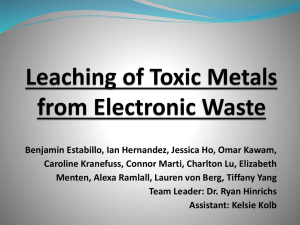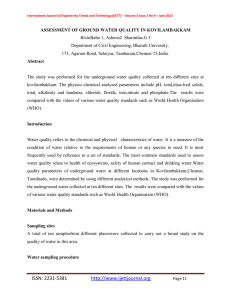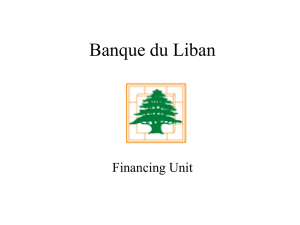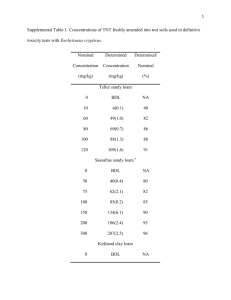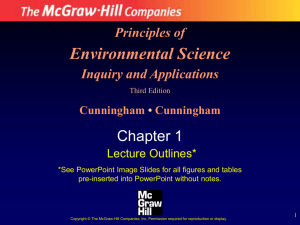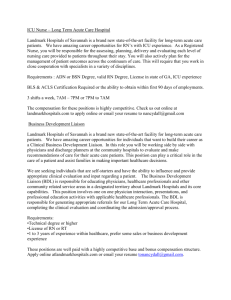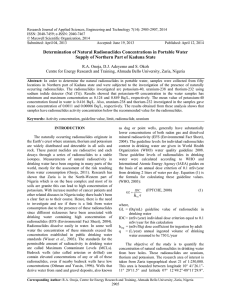Document 14671197
advertisement
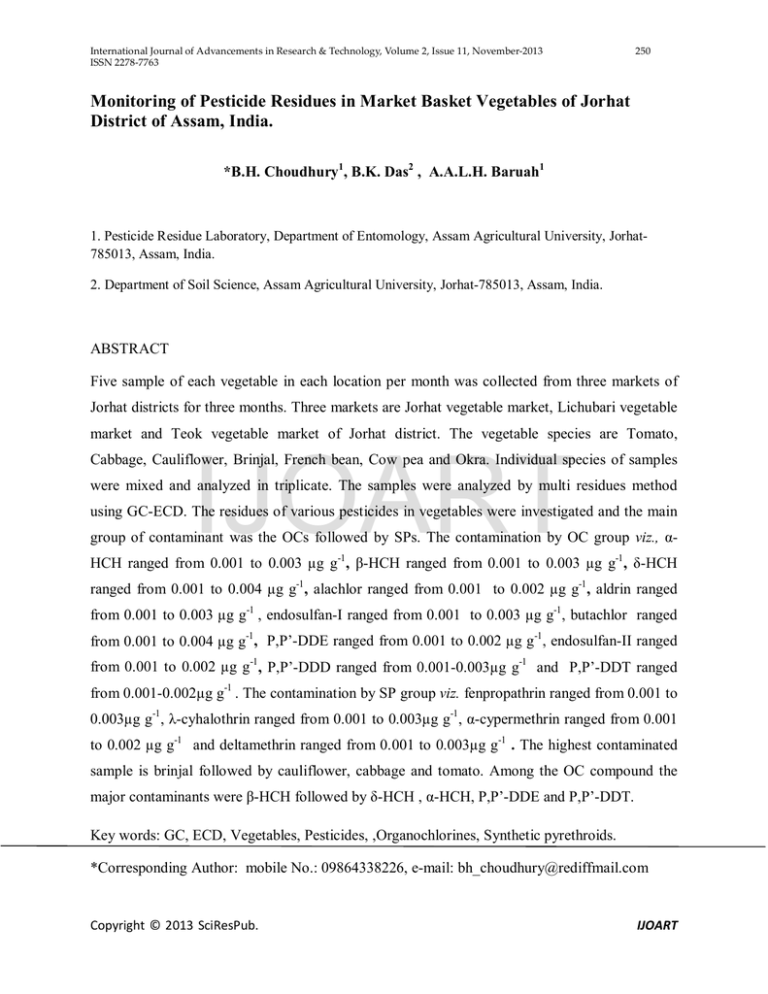
International Journal of Advancements in Research & Technology, Volume 2, Issue 11, November-2013 ISSN 2278-7763 250 Monitoring of Pesticide Residues in Market Basket Vegetables of Jorhat District of Assam, India. *B.H. Choudhury1, B.K. Das2 , A.A.L.H. Baruah1 1. Pesticide Residue Laboratory, Department of Entomology, Assam Agricultural University, Jorhat785013, Assam, India. 2. Department of Soil Science, Assam Agricultural University, Jorhat-785013, Assam, India. ABSTRACT Five sample of each vegetable in each location per month was collected from three markets of Jorhat districts for three months. Three markets are Jorhat vegetable market, Lichubari vegetable IJOART market and Teok vegetable market of Jorhat district. The vegetable species are Tomato, Cabbage, Cauliflower, Brinjal, French bean, Cow pea and Okra. Individual species of samples were mixed and analyzed in triplicate. The samples were analyzed by multi residues method using GC-ECD. The residues of various pesticides in vegetables were investigated and the main group of contaminant was the OCs followed by SPs. The contamination by OC group viz., αHCH ranged from 0.001 to 0.003 µg g-1, β-HCH ranged from 0.001 to 0.003 µg g-1, δ-HCH ranged from 0.001 to 0.004 µg g-1, alachlor ranged from 0.001 to 0.002 µg g-1, aldrin ranged from 0.001 to 0.003 µg g-1 , endosulfan-I ranged from 0.001 to 0.003 µg g-1, butachlor ranged from 0.001 to 0.004 µg g-1, P,P’-DDE ranged from 0.001 to 0.002 µg g-1, endosulfan-II ranged from 0.001 to 0.002 µg g-1, P,P’-DDD ranged from 0.001-0.003µg g-1 and P,P’-DDT ranged from 0.001-0.002µg g-1 . The contamination by SP group viz. fenpropathrin ranged from 0.001 to 0.003µg g-1, λ-cyhalothrin ranged from 0.001 to 0.003µg g-1, α-cypermethrin ranged from 0.001 to 0.002 µg g-1 and deltamethrin ranged from 0.001 to 0.003µg g-1 . The highest contaminated sample is brinjal followed by cauliflower, cabbage and tomato. Among the OC compound the major contaminants were β-HCH followed by δ-HCH , α-HCH, P,P’-DDE and P,P’-DDT. Key words: GC, ECD, Vegetables, Pesticides, ,Organochlorines, Synthetic pyrethroids. *Corresponding Author: mobile No.: 09864338226, e-mail: bh_choudhury@rediffmail.com Copyright © 2013 SciResPub. IJOART International Journal of Advancements in Research & Technology, Volume 2, Issue 11, November-2013 ISSN 2278-7763 251 1 INTRODUCTION India is an agrarian country. According to the census of India (2001), the total population of the nation is 1.027 billion in which 110.7 million are farmers, whereas the cultivated cropped area is about 124.07 million ha [1]. The global share of India in vegetable production is about 13.4%. A personal interview carried out among cultivators and local pesticide market showed that about 95% of farmers use synthetic pesticides in vegetable fields to protect their crops from different pests. In the year 2000, the vegetable production in India was 92.8 million tonnes, grown over an area of 6 million hectares, which is about 3% of the gross cropped area of the country. Potato is the most important vegetable crop in India as it occupies 20% of vegetable area and contributes 27% to the total vegetable production. Nevertheless, vegetable production has been diversifying gradually [2]. In the world, India occupies first position in the production of cauliflower, brinjal and peas, second in onion and third in cabbage [3] IJOART Vegetables form an important component of human diet. They are however, infested by various insect pests like aphids, jasssids, diamond moths, caterpillars, etc. Among the vegetables, brinjal, cauliflower, tomato and okra etc. are some very common vegetables cultivated, throughout the country but all are badly affected by insect-pest and diseases. Brinjal (Solanum melongenaL.) suffers heavily at fruiting stage due to attack of shoot and fruit borers causing 70% damage to the crop and making it totally unfit for human consumption [4],[5]. Cauliflower (Brassica oleracea) also an important vegetable crop with an annual production of 3.39 million tones, is heavily attacked by various insects, resulting in severe loss of quality and production [6] , [7] . Okra (Abelmoschusesculentus L.) is heavily infested by numerous insect pests for which different insecticides are used [8]. For better yield and quality, pesticides are repeatedly applied by farmers during the entire period of vegetable farming including the fruiting stage. Indiscriminate use of pesticides particularly at fruiting stage and non adoption of safe waiting period leads to accumulation of pesticide residues in consumable vegetables. Since most of the pesticides are toxic in nature, their continuous ingestion by man even in trace amounts, can result in their accumulation in body tissues with serious adverse effects on health [9]. Vegetables consume 14% of the total pesticides used in India, in which, the share of different types of pesticides in Indian agriculture market shows that organophosphorus (50%) ranked first, followed by pyrethroids (19%), organochlorines (18%), carbamates (4%) and biopesticides (1%) Copyright © 2013 SciResPub. IJOART International Journal of Advancements in Research & Technology, Volume 2, Issue 11, November-2013 ISSN 2278-7763 252 [10]. Pesticide application is a necessary step for coping with the pest related problems and therefore, it is very important to assess their residues in vegetables. Many countries have established regular monitoring programs for quantitative determination of residues in food products [11] as pesticide residues above the maximum tolerance limits (MRL) at harvest time are a subject of great concern both globally and nationally. Surveys carried out by institutions spread throughout the country indicate that 50 to 70% of vegetables are contaminated with insecticide residues [12]. Pyrethroids are synthetic derivatives of pyrethrins, the natural insecticides that are produced by certain species of Chrysanthemum. Pyrethroids of greatest interest to water quality include cypermethrin and fenvalerate. Pyrethroids are extremely toxic to aquatic organisms, with lethal concentration (LC50) values less than 1.0 ppb. They are applied in urban areas primarily for structural pest control, in agricultural areas and in the home as pet sprays and shampoos. Some of the new pyrethroids such as cypermethrin, which is used in much lower amounts, could IJOART be up to 20 times more toxic than permethrin [13]. The primary transport pathway for pyrethroids is receding waters from agricultural and urban applications through runoff. Pyrethroids are persistent compounds and feebly soluble in water [14]. Several recent monitoring studies in California have reported synthetic pyrethroid contamination of both surface waters and sediments [15], [16], [17] . Assam is a state where huge vegetables are produced in different vegetable growing pockets. These vegetables are transported to the various region of Assam including North Eastern States for millions of people. So a huge population is depends on the vegetables grown in various vegetable growing pockets of Assam which needs monitoring of pesticides residue. Hence, the present study was undertaken with the objective to monitor/quantify the residue levels of some most frequently used pesticides on vegetables in Jorhat districts of Assam so that contamination in vegetables due to pesticides can be removed or reduced. 2 MATERIAL AND METHODS Five sample of each vegetable in each location per month was collected from three markets of Jorhat districts for three months. Three markets are Jorhat vegetable market, Lichubari vegetable market and Teok vegetable market of Jorhat district. The vegetable species are Copyright © 2013 SciResPub. IJOART International Journal of Advancements in Research & Technology, Volume 2, Issue 11, November-2013 ISSN 2278-7763 253 Tomato, Cabbage, Cauliflower, Brinjal, French bean, Cow pea and Okra. Individual species of samples were mixed and analyzed in triplicate. These mixed samples were grind with the help of an electrical grinder. From this blended samples 100g were taken, mixed with 200ml of acetone and grinded in the electrical grinder for 2 min at high speed. After 2 min these samples were transferred to a Buchner funnel containing filter paper fitted with suction bottle and filtration was completed within less than 1 min. From this extract, transferred an aliquot of 80 ml to 1 litre separatory funnel. To this aliquot 200 ml mixture of hexane: dichloromethane (1:1, v/v) were added and shaken vigorously for 1 min. The lower aqueous phase was then transferred to another 1 litre separatory funnel. The organic phase of the first separatory funnel was dried by passing through approximately 1.5" sodium sulfate supported on pre-washed cotton in 4" funnel. To the separatory funnel containing aqueous phase, 10mL saturated sodium chloride solution was added and shaken vigorously for 30 sec. To this, 100 mL dichloromethane were added, shaken vigorously and lower organic phase was dried by passing through the same sodium sulfate used IJOART for drying the organic extract of the first separatory funnel. Repeated the extraction once more with 100 mL dichloromethane and dried as above. Sodium sulfate was rinsed with about 50 mL dichloromethane and the extract was concentrated by using vacuum rotary evaporator. Concentration step was repeated in the presence of hexane to remove all traces of dichloromethane, and the final volume (3ml) was made in n-hexane. The sample was then cleaned by column chromatography. The column of 22mm inner diameter was packed by placing solvent washed cotton plug at the bottom of column above which 2g of cleaned dried anhydrous sodium sulphate was placed. Then 4g activated florosil were placed slowly on the uniformly leveled clean anhydrous sodium sulphate. The florosil was leveled properly by shaking and above it again 2g clean anhydrous sodium sulphate was placed and leveled properly. The column was pre-wetted by pouring 50ml of double distilled n-hexane and the lower knob of column was remain open so that the solvent can elute drop by drop. Then the whole extract was placed drop wise in the column and eluted by using 50ml of 50% dichloromethane:1.5% acetonitrile: 48.5% hexane elution mixture. The eluant was collected and dried in rotary evaporator and the final volume was made 1 ml by using n-hexane which was injected to GC [18]. Copyright © 2013 SciResPub. IJOART International Journal of Advancements in Research & Technology, Volume 2, Issue 11, November-2013 ISSN 2278-7763 254 GC analysis: Samples were analyzed by using Shimadzu Gas Chromatograph (GC-2010) equipped with “Ni electron capture detector (ECD) and capillary column (DB-1, 30mxID-0.25mm) with AOC-20i auto injector. Operating conditions were: Injector temperature:2800C and Detector Temperature:3000C oven temperature programmed at 1700C (hold for 5 minute) - 2200C (hold for 10 minute and increased @1.50C )-2800C (hold for 7.0 minute and increased @4.00C ).The nitrogen used as carrier gas with flow rate 7.7 ml per minute with split less ratio. Reference standard of 21 pesticide mixture was obtained from M/S sigma Aldrich, USA. The list of pesticide along with retention time (Rt) are given in the table1. Table: 1 List of Organochlorine and Synthetic Pyrothroids pesticide along with retention time (Rt) Peaks Pesticide Rt(Minute) Recovery (%) LOQ(ng/kg) 9.02 83.08 0.02 Organochlorines (OCs) 1 α-HCH 2 β-HCH 10.08 84.00 0.02 3 δ-HCH 11.28 82.23 0.05 4 Alachlor 15.89 90.45 0.01 5 Aldrin 18.48 86.25 0.05 6 Endosulfan-I 24.69 88.03 0.05 7 Butchlor 25.77 92.00 0.01 8 P,P’-DDE 27.38 91.08 0.03 9 Endosulfan-II 27.85 93.09 0.05 10 P,P’-DDD 31.21 87.05 0.02 11 P,P’-DDT 35.41 94.04 0.01 12 Dicofol 41.93 87.30 0.03 IJOART Synthetic pyrethroids (SPs) 13 Fenpropathrin 43.14 88.09 0.02 14 λ-Cyhalothrin 51.41 94.40 0.01 15 Permethrin-I 55.20 87.32 0.06 Copyright © 2013 SciResPub. IJOART International Journal of Advancements in Research & Technology, Volume 2, Issue 11, November-2013 ISSN 2278-7763 255 16 Permethrin-II 55.91 88.90 0.03 17 β-Cyfluthrin 58.99 96.03 0.01 18 α-Cypermethrin 60.18 89.09 0.04 19 Fenvalerate-I 62.85 90.01 0.03 20 Fenvalerate-II 63.63 84.04 0.02 21 Delamethrin 65.64 92.08 0.03 3 RESULTS AND DISCUSSION Recovery experiments were carried out with the entire representatives group. The recoveries from vegetable samples fortified at the level of 0.1 and 0.01mg/kg varied from 80.23-96.03 per cent for all Organochlorine and Synthetic pyrethroids pesticides. Table 2: Pesticide residues (µg g-1) in tissues of vegetable sample collected from different markets of Jorhat districts of Assam during the month of November,2010. S. Pesticides No. IJOART Tomato Cabbage Cauliflower Brinjal French bean Cow pea Okra BDL 0.003 BDL 0.003 BDL 0.002 0.001 0.001 BDL 0.001 BDL 0.002 BDL 0.002 BDL 0.001 0.003 0.001 0.001 0.001 BDL 1 α-HCH 2 β-HCH 3 δ-HCH 4 Alachlor BDL BDL BDL BDL BDL BDL 0.001 5 Aldrin BDL 0.002 BDL 0.003 BDL BDL BDL 6 Endosulfan-I 0.002 BDL BDL BDL 0.001 BDL BDL 7 Butchlor BDL BDL 0.001 BDL BDL BDL BDL 8 P,P’-DDE BDL BDL BDL BDL BDL 0.001 BDL 9 Endosulfan-II BDL BDL BDL 0.002 BDL BDL 0.002 10 P,P’-DDD 0.001 BDL BDL BDL BDL 0.003 BDL 11 P,P’-DDT BDL BDL 0.001 BDL BDL BDL BDL 12 Dicofol BDL BDL BDL BDL BDL BDL BDL Copyright © 2013 SciResPub. IJOART International Journal of Advancements in Research & Technology, Volume 2, Issue 11, November-2013 ISSN 2278-7763 256 13 Fenpropathrin BDL BDL 0.003 BDL BDL BDL BDL 14 λ-cyhalothrin BDL BDL BDL BDL BDL BDL BDL 15 Permethrin-I 0.001 BDL BDL BDL BDL BDL BDL 16 Permethrin-II BDL BDL BDL BDL BDL BDL BDL 17 β-cyfluthrin BDL BDL BDL BDL BDL BDL BDL 18 α-cypermethrin BDL 0.002 BDL BDL BDL BDL BDL 19 Fenvalerate-I BDL BDL BDL BDL BDL BDL BDL 20 Fenvalerate-II BDL BDL BDL BDL BDL BDL BDL 21 Delamethrin BDL BDL BDL 0.001 BDL BDL BDL 0.004 0.006 0.005 0.006 0.004 0.006 0.006 Total IJOART Table 3: Pesticide residues (µg g-1) in tissues of vegetable sample collected from different markets of Jorhat districts of Assam during the month of December,2010. S. Pesticides No. Tomato Cabbage Cauliflower Brinjal French bean Cow pea Okra 0.002 BDL 0.001 BDL 0.002 BDL 0.001 1 α-HCH 2 β-HCH 0.001 0.002 BDL 0.001 BDL 0.003 BDL 3 δ-HCH BDL 0.001 0.003 BDL 0.004 0.001 0.001 4 Alachlor 0.001 BDL BDL 0.002 BDL BDL BDL 5 Aldrin BDL BDL BDL BDL BDL BDL 0.001 6 Endosulfan-I 0.003 BDL 0.001 BDL BDL BDL BDL 7 Butchlor BDL BDL BDL 0.004 BDL BDL BDL 8 P,P’-DDE BDL 0.002 BDL BDL 0.001 BDL BDL 9 Endosulfan-II BDL BDL 0.001 BDL BDL BDL BDL 10 P,P’-DDD BDL BDL BDL BDL BDL 0.001 BDL Copyright © 2013 SciResPub. IJOART International Journal of Advancements in Research & Technology, Volume 2, Issue 11, November-2013 ISSN 2278-7763 257 11 P,P’-DDT BDL 0.002 BDL BDL BDL BDL BDL 12 Dicofol BDL BDL BDL BDL BDL BDL BDL 13 Fenpropathrin BDL BDL BDL BDL 0.001 BDL BDL 14 λ-cyhalothrin BDL BDL BDL 0.002 BDL BDL BDL 15 Permethrin-I BDL BDL BDL BDL BDL BDL BDL 16 Permethrin-II BDL BDL BDL BDL BDL BDL BDL 17 β-cyfluthrin BDL BDL BDL BDL BDL BDL BDL 18 α-cypermethrin BDL BDL 0.001 0.001 BDL BDL BDL 19 Fenvalerate-I BDL BDL BDL BDL BDL BDL BDL 20 Fenvalerate-II BDL BDL BDL BDL BDL BDL BDL 21 Delamethrin BDL BDL BDL BDL BDL BDL BDL 0.0026 0.0026 0.0027 0.0022 0.0036 0.0014 0.0023 Total IJOART Table 4: Pesticide residues (µg g-1) in tissues of vegetable sample collected from different markets of Jorhat districts of Assam during the month of January,2011. S. Pesticides Tomato Cabbage Cauliflower Brinjal French bean Cow pea Okra No. 1 α-HCH BDL 0.001 0.002 BDL 0.001 0.002 BDL 2 β-HCH 0.002 BDL 0.001 0.002 0.003 BDL 0.001 3 δ-HCH BDL 0.003 BDL 0.001 BDL 0.001 BDL 4 Alachlor 0.002 BDL BDL BDL BDL BDL BDL 5 Aldrin BDL BDL BDL BDL 0.001 BDL BDL 6 Endosulfan-I 0.001 BDL BDL 0.001 BDL BDL BDL 7 Butchlor BDL BDL BDL 0.001 BDL BDL 0.001 8 P,P’-DDE BDL BDL 0.001 BDL BDL BDL BDL Copyright © 2013 SciResPub. IJOART International Journal of Advancements in Research & Technology, Volume 2, Issue 11, November-2013 ISSN 2278-7763 258 9 Endosulfan-II BDL BDL BDL BDL BDL BDL BDL 10 P,P’-DDD BDL BDL BDL BDL BDL BDL BDL 11 P,P’-DDT BDL BDL BDL BDL BDL BDL BDL 12 Dicofol BDL BDL BDL BDL BDL BDL BDL 13 Fenpropathrin BDL BDL BDL 0.001 BDL BDL BDL 14 λ-cyhalothrin BDL BDL BDL BDL BDL BDL 0.003 15 Permethrin-I BDL BDL BDL BDL BDL BDL BDL 16 Permethrin-II BDL BDL BDL BDL BDL BDL BDL 17 β-cyfluthrin BDL BDL BDL BDL BDL BDL BDL 18 α-cypermethrin BDL 0.002 BDL BDL BDL BDL BDL 19 Fenvalerate-I BDL BDL BDL BDL BDL BDL BDL 20 Fenvalerate-II BDL BDL BDL BDL BDL BDL BDL 21 Delamethrin BDL BDL 0.003 BDL BDL BDL BDL 0.0027 0.0033 0.0035 0.0026 0.0037 0.0016 0.0025 IJOART Total Average of three replicates, BDL: Below Determination Level Table 5: Month wise number of contamination of samples by pesticides Samples Tomato Nevemver,2010 4 December,2010 4 January,2011 3 Total 11 Cabbage 4 4 3 11 Cauliflower 5 5 4 14 Brinjal 5 5 5 15 French bean 3 4 3 10 Cow pea 4 3 2 9 Okra 4 3 3 10 The present study was undertaken to determine the concentration of different pesticides residues in market basket vegetables of Jorhat district. Pesticides are known to be present in Copyright © 2013 SciResPub. IJOART International Journal of Advancements in Research & Technology, Volume 2, Issue 11, November-2013 ISSN 2278-7763 259 vegetables due to extensive use of corresponding pesticides in interfiled cultivation. The residues of various pesticides in vegetables are presented in table 2, 3 and 4.The results revealed that the main group of contaminant is the OCs followed by SPs. However, the degree of contamination of later group is negligible. The contamination by OC group viz., α-HCH ranged from 0.001 to 0.003 µg g-1, β- HCH ranged from 0.001 to 0.003 µg g-1, δ-HCH ranged from 0.001 to 0.004 µg g-1, alachlor ranged from 0.001 to 0.002 µg g-1, aldrin ranged from 0.001 to 0.003 µg g-1 , endosulfan-I ranged from 0.001 to 0.003 µg g-1, butachlor ranged from 0.001 to 0.004 µg g-1, P,P’-DDE ranged from 0.001 to 0.002 µg g-1, endosulfan-II ranged from 0.001 to 0.002 µg g-1, P,P’-DDD ranged from 0.001-0.003µg g-1 and P,P’-DDT ranged from 0.001-0.002µg g-1 . The contamination by SP group viz. fenpropathrin ranged from 0.001 to 0.003µg g-1, λ-cyhalothrin ranged from 0.001 to 0.003µg g-1, α-cypermethrin ranged from 0.001 to 0.002 µg g-1 and deltamethrin ranged from 0.001 to 0.003µg g-1. The degree of contamination of individual sample during the three months is almost same. The highest contaminated sample is brinjal IJOART followed by cauliflower, cabbage and tomato. Similar results are also reported by Charan et al. [19] in farm gate vegetables. Among the OC compound the major contaminants were β-HCH followed by δ-HCH, α-HCH, P,P’-DDE and P,P’-DDT. All the samples were contaminated by one or more pesticides. The result of study reveals that all the samples were contaminated with different pesticide residues. Of course no contaminated samples were exceeded the maximum residual limit (MRL) values as per the FAO/WHO [20].Therefore, periodic monitoring of market basket vegetables must be carried out to know the prevailing scenario of pesticide contamination of vegetables grown in Jorhat district. 4 CONCLUSION The present research will not only serve as reference document but also helpful in taking necessary and timely preventive measure to mitigate such problems. The investigation reveals that the consumption of vegetable is safe from consumer’s point of view as residues of all the pesticides were far below their MRLs, though the vegetable eater is not so safe for which safety measures have to be adopted to protect the future generation. ACKNOWLEDGEMENT Copyright © 2013 SciResPub. IJOART International Journal of Advancements in Research & Technology, Volume 2, Issue 11, November-2013 ISSN 2278-7763 260 The authors express gratitude to the Department of Entomology, Assam Agricultural University, Jorhat-13 for providing facilities to carry out the research work. REFERENCES [1] Prasad, S. S., 2001. Programme Advisory Committee, Country Report - India, Governmentof India. [2] Kumar, S., Pal, S., Joshi, P. K.,2004. Impact of Vegetable Research in India. NCAP Publication. 9-33 [3] Pandey, U. B.,2004. Development programmes and policies for accelerated production of vegetables in India. In Food Security and Vegetables – A Global Perspective.Eds: Premnath, P. [4] Misra, P. N., Singh, M. P.,1996. Chemical control of okra in the Terai region Uttar IJOART Pradesh. Indian J. Ent. , 45(2), 152-158. [5] Duara, B., Baruah, A., Deka, S. C., Burman, N.,2003. Residues ofbcypermethrin and fenlerate on brinjal. Pesticide Res. J. , 15(1), 43-46. [6] Regupathy, A., Habeebullah, B., Balasubramanium, M., 1985. Dissipation of insecticides applied to control Plutellaxylostella Curtis and Spodopteralitura in cauliflower. Pesticide Res. J., 19(9), 53-56. [7] Patel,B. A., Shah, P. G., Rajm, M. F., Patel, J. A., Talati, J. G., 1999. Clorpyriphos residues in/ on cabbage and brinjal. Pesticide Res. J. , 11(2), 194-196. [8] Sinha, S. R., Sharma, P. K., 2000. Efficacy of neonicotinoids against okra insect pest. Pesticide Res. J., 19(1), 42-44. [9] Handa, S. K., Agnihotri, N. ., Kulshrestha, G., 1999. Pesticides Residues: Significant Management and Analysis. Research Periodicals and Book Publishing Home, Texas, USA. [10] Dhaliwal, G. S., Singh, B., 2000. Pesticides and Environment. Commonwealth Publishers , New Delhi. [11] Reed, D. V., Lombardo, P., Wessel, J. R., Burke, J. A., Macmohan, B., 1987. The FDA pesticides monitoring programme. J.AOAC.,70 , 591-595. Copyright © 2013 SciResPub. IJOART International Journal of Advancements in Research & Technology, Volume 2, Issue 11, November-2013 ISSN 2278-7763 261 [12] Karanth, N. G. K., 2002. Challenges of Limiting Pesticide Residues in Fresh Vegetables: The Indian Experience. In E. Hanak, E. Boutrif, P. Fabre and M. Pineiro, (Scientific Editors), Food Safety Management in Developing Countries. Proceedings of the International Workshop, CIRAD-FAO, Montpellier, France. 11-13. [13] Amweg, E. L., Weston, D. P., Ureda, N. M., 2005. Use and toxicity of pyrethroid pesticides in the central Valley, California. Environ Toxicol Chem., 24, 966-972. [14] Laskowaski, D. A., 2002. Physical and chemical properties of pyrethroids. Rev Environ Contam Toxicol., 174, 49-170. [15] Hengel, M. J., Mover, C. R., Shibamoto, T., 1997. New method for analysis of pyrethriod insecticdes: esfenvalerate, cispermethrin, and trans-permethrin, in surface waters using solid-phase extraction and gas chromatography. BullEnviron Contam Toxicol. ,59, 171-178. [16] Wetson, D. P., You, J., Lydy, M. J., 2004. Distribution and toxicity of sediment- IJOART associated pesticides in agriculturadominated water bodies of Californias Central Vally. Environ Sci Technol., 38, 2752-2759. [17] Gan, J., Lee, S. J., Liu, W. P., Haver, D. L., Kabashina, J. N., 2005. Distribution and persistence of pyrethroids in runoff sediments. J Environ Qual., 34, 836-841. [18] Sharma, K. K., 2007. Pesticide Residue Analysis Mannual. 94-98 [19] Charan, P. D., Ali, S. F., Kachhawa, Y. and Sharma, K., 2010 . Monitoring of Pesticide Residues in Farmgate Vegetables of Central Aravalli Region of Western India AmericanEurasian .J. Agric. & Environ. Sci., 7 (3), 255-258. [20] FAO/WHO 1986. Maximum limits for pesticide residues. Codex Alimentaries Vol. XIII, 2 edition, Rome. Copyright © 2013 SciResPub. IJOART
